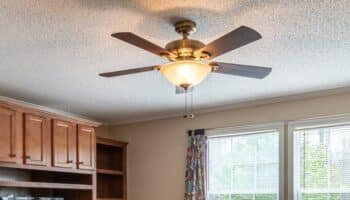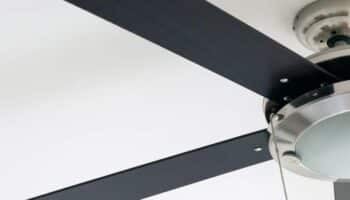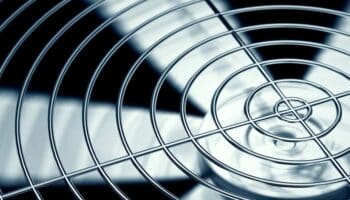We've independently reviewed this article to make sure it's as accurate as we can make it.
To find out more about our article creation and review process, check out our editorial guidelines.
Are you having a hard time comparing flush mount vs downrod ceiling fans?
You’re not alone! Understanding the differences between both fans can be a bit challenging.
Luckily, you’ve come to the right place for answers.
When it comes to choosing a ceiling fan, flush and downrod are the most common options. Flush mount ceiling fans offer a sleek look, a remote option, and no need for a downrod. Downrod fans, on the other hand, provide better stability and airflow while maintaining a safe distance from the ceiling.
Read on to learn more about the differences between them!
Flush Mount vs Downrod Ceiling Fans
In this section, I’ll guide you through the seven key differences between downrod vs flush mount ceiling fans to help you make the right choice.
#1 Price
When comparing flush mount and downrod ceiling fans, my usual advice is to consider their price.
Due to the greater design flexibility, downrod ceiling fans are significantly more expensive.
Therefore, the flush ceiling fan is the clear winner in the price category.
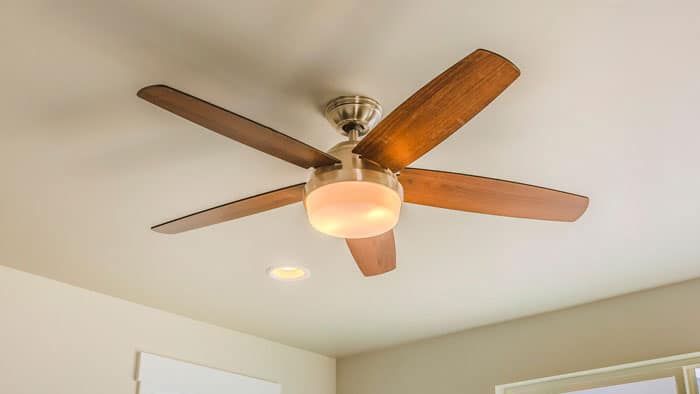
Don’t worry; just because the flush fan is close to the ceiling doesn’t mean you can’t find a beautiful option that fits your home for an affordable price.
#2 Features
Now, let’s compare flush mount and downrod ceiling fans regarding features.
Both fans have various features, including the ability to customize lighting and use a remote control to regulate the speed and lights.
Also, both ceiling fans have a reversible motor to change the direction from downdraft summer to updraft winter mode. They also offer various speeds.
From an innovation and design standpoint, you have more aesthetic features available on downrod products than flush.
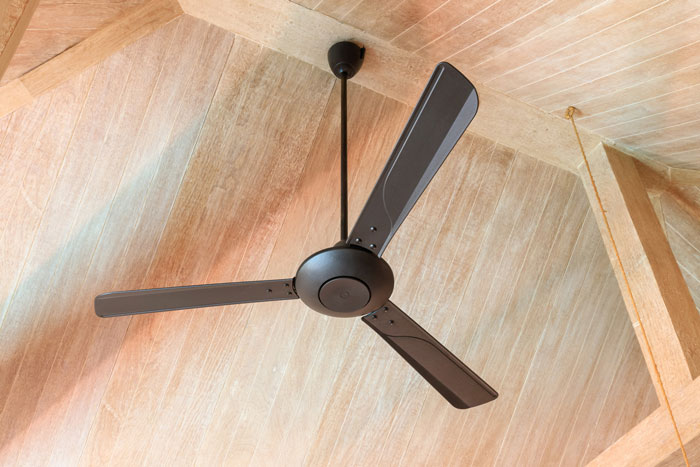
For instance, the blades can be designed as leaves to give your sunroom a tropical feel, or the material could be bamboo for a more sustainable option. Given that these two options are neck-and-neck, the downrod fan edges out the flush-mounted fan because of the countless aesthetic features.
#3 Ease of Use
Keeping in mind the ease of use when comparing flush mount vs downrod ceiling fans is also important.
Since both options are available with remotes, it’s a tie, so viewing this category without remote controls is important.
Given that downrod ceiling fans have long rods mounted on high ceilings and are unreachable without a ladder, the flush version is the hands-down winner.
I find that a flush-mount ceiling fan can easily be accessed on a low ceiling, and most contain pull chains to adjust the light or fan speed without requiring a remote.
Also, when the lightbulb goes out, flush ceiling fans are much easier to disassemble and change out the bulb.
#4 Power
When purchasing a new flush mount or downrod ceiling fan, I also recommend considering the power consumption.
You’ll be happy to know that most residential ceiling fans do not consume much power, which is why they are such great options for kicking around the air in the summer and winter.
Also, ceiling fans with lights typically use energy-efficient LED lighting with a brighter output and longer lifespan than traditional lightbulbs.
The power consumption depends on the model you purchase, so the power category is a tie.
#5 Noise
Let’s compare flush mount vs downrod ceiling fans regarding noise level.
Flush ceiling fans use a less expensive and less powerful motor to prevent the air from bouncing between blades, which results in noisy motors.
On the other hand, downrod ceiling fans are fairly high away from the user and have enough space between the blades and the ceiling to create noise, so they operate much more quietly. Therefore, the clear winner in the noise category is the downrod ceiling fan.
#6 Warranty
From what I’ve seen, the warranties between flush and downrod ceiling fans vary greatly depending on the retailer, brand, and model.
The general rule of thumb is the motor and motor-related parts have a full warranty for the original purchaser. So, if you purchase a new home and keep the previous owner’s fans, you are not covered under warranty.
Also, LED lights and electrical components commonly have a full warranty from the original purchaser for up to five years.
Blades, rods, finishes, housing, switches, and light kits only have a warranty of one year. Since warranties depend on many factors, this category is a tie.
#7 Maintenance
Comparing flush mount and downrod ceiling fans in terms of maintenance involves considering factors such as cleaning, accessibility, and upkeep.
The clear winner in the ease-of-maintenance category is the flush ceiling fan. Since it is closer to the ground, it is much easier to access without dragging a tall ladder from the garage or shed.
So, lights can easily be changed, the lighting housing can be cleaned, and the blades can be dusted.
Pros and Cons: Flush Mount vs Downrod Ceiling Fans
There are several pros and cons to each option that you must consider before choosing a downrod or flush mount ceiling fan. These include:
Pros
Flush mount and downrod ceiling fans can significantly lower or raise the temperature of any room by circulating the area, taking the burden off the HVAC system and saving you money on utility bills.
In my opinion, one of the best advantages of a flush ceiling fan is that you do not require a downrod which removes one complicated step during the installation process. It also means there will be less opportunity for tall family members or visitors to bump their heads. Flush mount ceiling fans also deliver a sleek and modern aesthetic.
On the other hand, downrod ceiling fans offer the best performance due to the airflow above the unit.
Since there is space, there are many innovative styles and options available. Downrod ceiling fans are also fairly quiet since they are further away from the floor, and the motor does not need to work as hard to move the blades. Additionally, they are much easier to install on a sloped ceiling than flush-mount fans.
Cons
From what I’ve seen, the noise level is one of the greatest disadvantages of the flush ceiling fan.
Since the blades are closer to the ceiling, they must work harder to force air down, thus increasing motor usage. Also, the limited space makes many lighting fixtures less attractive than other ceiling fan options.

One of the biggest cons of installing a downrod fan is that it’s difficult to clean and perform simple maintenance, like changing a lightbulb. Also, if you don’t measure the rod length correctly, it could be much too short, thus impeding airflow, or much too long, causing tall visitors to hit their heads.
Here’s a quick summary of everything we’ve discussed so far:
| Pros | Cons |
|---|---|
| You don’t require a downrod | High noise level |
| More affordable | Lighting fixtures are not as attractive as other fans |
| Ideal for low and flat ceilings |
| Pros | Cons |
|---|---|
| Best performance available | Difficult to clean and maintain |
| Fairly quiet | More expensive |
| Easier to install on a sloped ceiling |
FAQ
Please keep reading if you still haven’t decided about flush or downrod ceiling fan placements.
In this section, I’ll answer frequently asked questions to help you make the right choice!
Do Flush Mount Ceiling Fans Work as Well as Downrod?
From a performance perspective, downrod ceiling fans are superior because they allow for much better air circulation due to the airflow above the unit.
However, if you have a smaller room with low ceilings, then you probably don’t need as much airflow.,
Can You Convert a Downrod Ceiling Fan to a Flush Mount?
Yes, it is possible to remove the rod from your ceiling fan to convert it into a flush-mounted unit.
But, before making the transition, it is critical to ensure all screw holes and screws exist so that the unit can be changed.
The same is possible for converting a flush mount to a downrod ceiling fan. You must first purchase an extension rod from any home store. It is important to research before making this transformation since the conversion ability depends on the style and brand you have purchased.
Final Verdict: Flush Mount or Downrod Ceiling Fan?
Hopefully, now you know all the differences between a flush mount and a downrod ceiling fan.
You should use a flush mount ceiling fan in rooms with low and flat ceilings or in spaces where a lower fan fixture profile is desired. Flush ceiling fans are mounted directly to the ceiling without an extra attachment.
For a sloped ceiling or a room over 8 feet tall, downrod ceiling fans are the best option.
The ultimate decision will vary depending on your needs and preferences.
Thank you so much for reading this article; please check out our related posts below!
Good luck.





